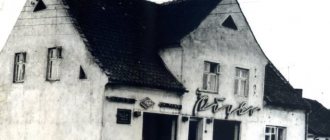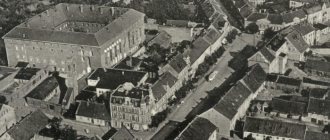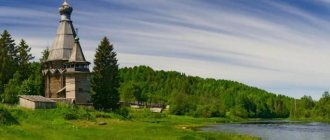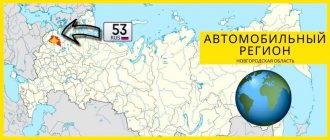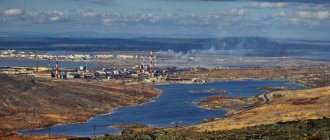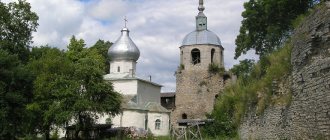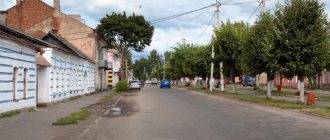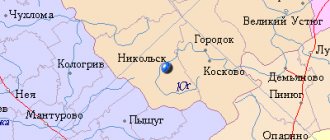The city of Kaliningrad (formerly Koenigsberg) occupies the position of a semi-exclave in relation to the Russian Federation: they do not have a common border. The region neighbors Lithuania and Poland and has direct access to the ice-free Baltic Sea. This convenient location allows the city area to have sustainable development. In recent years, Kaliningrad has been recognized several times as the best Russian city.
Königsberg Castle (“royal mountain”), which arose in the second half of the 13th century, is closely connected with the history of the knights of the Teutonic Order. It was they who moved their capital here from Poland. And then they contributed to the development of the Duchy of Prussia, where power belonged entirely to the church hierarchy. Cities flourished around the fortress:
- Altstadt
- Lebenicht
- Kneiphof
They were destined to unite with Koenigsberg, which became the capital of the Prussian state in 1724. A few years later, the capital of Prussia briefly became a Russian city as a result of the defeat of the “Prussians” by Russian troops in the Seven Years’ War.
Historians tend to assess the four-year period of Russian rule as positive for the development of the city. The industrialization of Koenigsberg began later, when woodworking and shipbuilding began to develop.
By the beginning of the First World War, the city had become a major international trading port and at the same time was a German exclave after Germany's defeat in the war. It was separated from the country by the Polish corridor. This affected the development of the territory: Koenigsberg was the most backward German city due to its distance from Germany. This is how he entered the Second World War.
In 1944, British aircraft destroyed the central part of the city, historical monuments and thousands of civilians were damaged. In April 1945, Soviet troops under the command of Marshal Vasilevsky successfully completed the assault on Koenigsberg, achieving the complete surrender of German troops.
The future fate of the Prussian city was finally decided after the complete victory of the Soviet troops - according to the Potsdam decision, part of the Prussian lands, along with Koenigsberg, went to the Soviet Union, and in July 1946 the city was renamed Kaliningrad and became the center of the region of the same name. A new era began in the history of the ancient Prussian city.
Recent history of Kaliningrad
During the Soviet period, the development of Kaliningrad will highlight several stages:
- The Great Migration of Peoples. In 1946, at the call of the government, citizens from all Soviet republics began to move to the Kaliningrad region. This determined the multinational composition of the region. The Germans left the city and rushed to Germany.
- The fight against devastation. Kaliningrad was almost completely destroyed: enterprises, transport, water supply and sewage systems did not function. The settlers had to work hard to restore the national economy, buildings and residential buildings. Their work was appreciated by an award - the Order of the Red Banner of Labor.
- In isolation. With the collapse of the USSR, the situation in the regional center and the entire region worsened. With the entry of Lithuania into the European Union, Russian citizens could not enter the region without a foreign passport and visa. In order to develop the isolated territory, the Russian government is carrying out a set of events related to the 750th anniversary of the city’s founding and the 60th anniversary of its entry into Russia.
- From support to development. In 2003-2007, the region improves its indicators of socio-economic development, becoming the second region (after St. Petersburg) in the Northwestern Federal District. Receives recognition from the Council of Europe.
- Industrial giant. In the region, passenger cars and complex household appliances are being assembled, furniture production is developing, and enterprises in the light and food industries are strengthening their positions. Shipbuilding is further developed at JSC Baltic Shipbuilding. A special economic zone regime is being introduced in the region, in which 34 thousand enterprises of various types of property operate. 67 percent of all enterprises are concentrated in Kaliningrad.
Kaliningrad region
Geographical position
The Kaliningrad region is the extreme western region of the Russian Federation and does not have common borders with other constituent entities of the country.
The Kaliningrad region is separated from the main part of Russia by Lithuania, Latvia and Belarus, the region also borders on Poland, and the western coast faces the Baltic Sea. The length of the region's borders is 540 km, of which 210 km fall on Poland, 200 km on Lithuania, and the remaining 130 km on the sea. Geographically, the Kaliningrad region belongs to Central Europe and is a structural part of the Northwestern Federal District of Russia. From west to east the region stretches for 205 km, and from north to south – for 108 km. The area of the territory is 13.3 thousand km2, and taking into account the water areas of the Kaliningrad and Curonian Lagoons of the Baltic Sea it increases to 15.1 thousand km2.
The administrative center of the region is the city of Kaliningrad, or former Koenigsberg, two hours ahead of Greenwich time. The time difference with Moscow is one hour. The transition to winter time is not carried out, as in all other regions of Russia.
Relief
The main relief structures of the Kaliningrad region are hilly plains and lowlands, some areas of which are below sea level. The region's territory is the western edge of the vast East European Lowland, its geological forms are part of the Baltic Basin. A significant area is occupied by the Pregol-Instruchskaya lowland plain, located at an altitude of no more than 50 m above sea level, from the south it is bordered by the Baltic ridges, which are low hills, and in the north the Primorskaya Lowland approaches the sea. The highest point of the relief, reaching 240 m, is located in the east of the region, where the Vishtynets Upland is located. Negative heights can be observed on the coast of the Curonian Lagoon, these are the so-called polders - areas of territory fenced off from the sea by dams.
The external appearance of the relief of the Kaliningrad region was formed under the influence of the last Valdai glacier, sliding down to the sea from the Scandinavian mountains. As the glacier flowed, it leveled the territory and formed vast basins characterized by high humidity and an abundance of marshy areas. The average absolute height of the area is 15 m above sea level, relative heights rarely exceed 20 m. A significant area of the Kaliningrad region is occupied by reclamation canals and artificially drained areas.
The Kaliningrad region is not one of the regions very rich in minerals, but its main asset is its amber deposits. 90% of the world's amber reserves are located in the region and in certain areas of the sea shelf. In addition to amber, phosphorites, peat, brown coal, rock salt, titanium, zirconium and manganese ores are mined. In the depths of the region there are small deposits of oil and mineral waters.
Climate
The climate of the Kaliningrad region, closer to the coast of the Baltic Sea, is typically maritime; to the east, inland, it changes to temperate continental. It is warmer near the sea, the average annual temperature on the coast is 7.5°C, in the northern and western parts of the region it is slightly lower, approximately 6.5°C. The coldest month is January, the average air temperature in the winter season is 4°C with a minus sign, the minimum reaches -23°C. The warmest month is July; in summer, the average air temperature is +18°C, the maximum exceeds +26°C.
Due to the proximity of the sea, the climate is damp, winters are much warmer and milder than in the continental regions of Russia. Severe frosts occur very rarely, the snow cover is thin, and when it falls, it does not remain for a long time and melts quickly. Summer is cloudy and rainy, hot days with plenty of sun are rare. It rains on average 185 days during the year, with most of it falling in summer and autumn, but you can enjoy fine days only 68 times a year. There is stable snow cover for about 55 days. The average annual precipitation in the region ranges from 600 to 750 mm. In autumn, cyclones from the sea approach the region, bringing stormy winds and thunderstorms. Droughts are common in spring. The climate of Kaliningrad is characterized by an average annual air temperature of +7.9°C, precipitation with a norm of 820-840 millimeters.
Hydrography
The Kaliningrad region is distinguished by its wealth of water resources; the territory is cut by valleys of large and small rivers belonging to the Baltic Sea basin. In total, the region is crossed by 148 rivers, the largest watercourses are the Neman and Pregolya, the remaining rivers are their tributaries. The Neman, originating on the slopes of the Minsk Upland in Belarus, has two tributaries within the boundaries of the region - Sheshupe and Tylzha, flows into the Curonian Lagoon, forming a delta with many islands. The Pregolya is the longest watercourse within the region, it has four tributaries - Pissa, Instruch, Lava, Angrapa, and flows into the Kaliningrad Bay. Both large rivers are connected by a canal.
On the territory of the region there are many small rivers and streams, the length of which does not exceed 10 km, some of them do not flow into the Neman or Pregolya basins, but flow directly into the sea. The Rzhevka River and its tributaries flow into the Curonian Lagoon, and the Prokhladnaya River with its numerous tributaries flows into the Kaliningrad Bay. The network of watercourses is very dense; there are about 4,500 streams within the region alone. The total length of all rivers in the region is 13 thousand km, of which 70% are small rivers and streams.
The rivers have a mixed supply, 40% of the annual flow is replenished by melted snow water, 35% by rain, 25% by groundwater. In the spring, when the snow melts, there is high water; in summer and winter, when watercourses are fed mainly by groundwater, there is low water. The ice regime is unstable, the thickness of the ice cover on rivers varies from year to year: in cold winters it reaches 70 cm, and if the winter is mild, it does not exceed 15 cm, or even does not form at all.
The only large body of water in the Kaliningrad region is Lake Vishtynetskoe, located on the border with Lithuania, with an area of 16.6 km2. The remaining 38 reservoirs are very small, including both natural lakes and oxbow lakes, as well as artificial ponds and reservoirs formed at hydroelectric power stations or on the site of former quarries. The Kaliningrad and Curonian Lagoons can also be called inland bodies of water - estuaries, since they are separated from the sea by spits, and the water in them is fresh.
Vegetable world
Geographically, the Kaliningrad region is included in the zone of broad-leaved forests, but they were completely cut down two centuries ago. Their place was taken by artificially planted mixed and coniferous forests, in which spruce, pine, birch, maple, beech, ash and linden trees predominate, with occasional areas of oak forests. Of particular ecological value is the unique grove of black alder, as well as the so-called Red Forest, where rare plant species grow. The region is provided with forests by 18.5%; the eastern territory is characterized by the greatest forest cover.
The Kaliningrad region is replete with marshy areas. The total area of swamps in the region reaches 1000 km2, and their flora is surprisingly rich and diverse. In addition to the usual mosses, lichens, berries and mushrooms, irises, lilies and other rare plants that are under protection grow in the swamps.
Animal world
The fauna of the Kaliningrad region is distinguished by great diversity. The region is permanently home to about 340 species of terrestrial vertebrates, more than 320 species of birds, and more than 50 species of fish are found in the bays of the Baltic Sea. 45% of the vertebrate fauna, including 21 species of mammals, 111 species of birds, 4 species of amphibians, 12 species of fish, are rare and are under protection. Birds from Northern Europe migrate annually through the Kaliningrad region for wintering.
Among the ungulates, the region is inhabited by elk, large herds of roe deer and red deer, fallow deer, and sometimes sika deer and wild boar enter the territory. There are many small fur-bearing predators in the forests - martens, foxes, ferrets, weasels, and stoats. But wolves in the region were completely exterminated by the end of the 20th century. Among rodents, squirrels, beavers and muskrats are ubiquitous. Birds are mainly represented by passerines: starlings, finches, bramblings, warblers, warblers. In the forest thickets you can find hazel grouse and black grouse, in the meadows - partridges and storks, in the rivers and swamps - wild geese, ducks, cranes and waders. Birds of prey include hawks, owls, eagle owls, and owls.
History of the Kaliningrad region
The history of the region dates back to the beginning of the 13th century, when the Teutons decided to seize Prussian lands along the shores of the Baltic Sea and conquer pagan tribes. Having won the victory, on the site of the destroyed pagan temple, the crusaders erected a wooden fortress, which they called the Royal Mountain, or Koenigsberg. Gradually, the area around the citadel was built up with German villages and monasteries. The city grew and developed; in the mid-15th century, the Teutonic Order founded the Prussian Duchy and made the fortress its capital.
In 1807, the city was captured by the Napoleonic army, the region came under French rule, but not for long - in 1813 it was liberated by Russian troops. The second half of the 19th century was a calm and productive time, Königsberg was renovating and expanding. In 1918, on November 28, a popular uprising broke out, the Königsberg magistrate was forced to resign, and power was transferred to the Council of Workers' and Soldiers' Deputies. But already on March 3, 1919, the uprising was brutally suppressed by government troops, although this could not restore royal power.
Koenigsberg suffered heavy losses and destruction during World War II. Already in 1941, the city was actively bombed by Soviet pilots. And in April 1945, during an assault operation by Russian troops, its streets were turned into ruins. The city announced its capitulation on April 9. At the Potsdam Conference, it was decided to transfer Koenigsberg and the surrounding lands to the USSR, so the city acquired a new name - Kaliningrad. In the post-war period, the city and region were actually repopulated and restored at an accelerated pace. Nowadays Kaliningrad is a major port and military hub, where the headquarters of the Russian Baltic Fleet is located.
Population of the Kaliningrad region
The population of the Kaliningrad region is about 980 thousand people, of which 78% are urban residents. According to the population census conducted in 2010, Russians predominate among the residents of the region - 86%. A significantly smaller percentage of the population is occupied by Ukrainians, Belarusians, Lithuanians, Armenians, and Germans. There are several Tatar, Jewish and Gypsy communities. The majority of the population adheres to the Orthodox religion, although there are quite a few Catholic and Lutheran parishes. There are Jewish temples and Muslim mosques, Baptist and Jehovah's sects.
Economy
There are more than 6,000 enterprises in the Kaliningrad region, the vast majority of which are in the mining industry - about 5,700. 120 companies are engaged in the extraction of fossil raw materials, about 200 enterprises produce and distribute gas and water, electrical and thermal energy. The most developed industries are woodworking, electrical engineering production, furniture production, and the food industry. There are plans to create three powerful industrial parks.
Among the branches of the food industry, fish farming and the production of fish products are the most developed. The largest fishing ports are located in Kaliningrad, the villages of Pionersky and Svetly. Kaliningrad companies mainly specialize in the production of canned and semi-finished products from sea fish and caviar.
Main energy. It consists of four thermal power plants, the newest and largest of which is Kaliningrad CHPP-2 with a capacity of 450 MW, a state district power station and two hydroelectric power stations, as well as about 10 thousand gasoline and diesel thermal power plants with a total capacity of up to 30 MW. Alternative energy is actively developing in the region. The Zelenograd wind power plant, the largest wind farm in Russia, operates in the region. To generate thermal energy, mainly oil derivatives, natural gas, and coal are used. The Kaliningrad region is fully self-sufficient in energy.
Tourism
Tourism is one of the priority areas of the region's economy. Tourists are attracted by the healing climate of the Baltic Sea, mineral waters and mud, beautiful freshwater bays with sandy beaches and spits, picturesque lakes and rivers. The main centers of tourism and balneological resorts are the cities of Svetlogorsk and Zelenogradsk. Travelers are also attracted by the abundance of historical monuments and attractions of Sovetsk, Tilsit, Gusev, Pravdinsk. Equestrian sports enthusiasts visit Chernyakhovsk, where the largest stud farm in Russia is located. On the large rivers of the region you can ride kayaks, canoes, yachts or boats.
Population and climate
About 450 thousand people live on an area of 220 square kilometers, according to official data. In fact, the population of Kaliningrad has exceeded half a million citizens due to legal labor migrants from the republics of the former Soviet Union.
According to national composition, the following people live in Kaliningrad:
- Russians
- Ukrainians
- Belarusians
- Armenians
- Tatars
- Lithuanians
- Germans
- Poles.
It should be noted that the former indigenous peoples in the structure of the national composition of Kaliningrad make up half a percent - about 2 thousand people.
Kaliningrad was recognized as the best city in Russia in terms of amenities and a place where it is pleasant to live. The unemployment rate in the regional center does not exceed 0.5 percent, while in the region this figure was 1 percent of the economically active population (as of the end of 2014). More than half of the unemployed are women of working age. 38 percent of the number of unemployed Kaliningrad residents are rural residents.
There is an oversupply of certified lawyers and electronic equipment installers in the labor market. Medical workers and construction workers remain in demand on the labor market.
Half of all pensioners in the region live in Kaliningrad - more than 120 thousand people. The average salary in Kaliningrad is 32 thousand rubles, which is 2.5 thousand rubles more than in the region as a whole. The highest salaries - up to 45 thousand rubles - are at mining enterprises.
The climatic conditions in the region can be called favorable. The weather is influenced by the ice-free Baltic Sea and the warm Gulf Stream. Winter here is warmer than on mainland territories, spring is early and long. The same can be said about autumn, the beginning of which coincides with the calendar. The swimming season in the Baltic begins in mid-June - the summer period is moderately cool.
Kaliningraders love the mild Baltic winter, the average temperature of which is around zero degrees. The January weather is often marred by severe storms. Extremely low January temperatures are rather an exception. Despite the proximity of the sea, air humidity in average annual values does not exceed 80 percent.
Ecology of Kaliningrad
The main sources of air pollution within the city are transport. In terms of availability of personal passenger transport, Kaliningrad ranks 5th in the Russian Federation. There are almost 350 vehicles per thousand inhabitants. The most unfavorable streets in the city in terms of nitrogen oxide content:
- Gorkogo Street
- Dzerzhinsky Street
- Victory Avenue
- Peace Avenue
- Sovetsky Prospekt
- Leninsky Prospekt
With changes in traffic flows and their redistribution from the central part of the city, the environment has been significantly improved.
Leningradsky is considered the best area to live, where new residential complexes are located in green areas.
Investments in the economy
Kaliningrad is a favorable city for investment. Not only all-Russian cash flows flow here, but also foreign capital. Investors invest money in industry, development of transport infrastructure and communications.
Large investment flows are aimed at the reconstruction of the Khrabrovo international airport, which, with its dilapidated appearance, terrified visitors to the city. The project provides for the development of both an airport terminal and a multifunctional commercial complex. The development of the international airport’s infrastructure has begun at a very opportune time – it will provide comfortable conditions for those arriving for the 2022 FIFA World Cup. How the gateway of the city will improve the investment attractiveness of the region. Until mid-2013, the shabby terminal building caused a lot of criticism from city guests.
Projects to create investment brands have been successfully implemented in Kaliningrad:
- LLC "Ivan Taranov Breweries"
- CJSC Almazholding
- LLC "Lesobalt"
- JSC Avtotor
- LLC "Fish Village"
According to the Ministry of Regional Development of the Russian Federation, there are over 40 investment sites in the region. The largest project accumulated 12 billion rubles - the construction of a new housing complex in the village of Kholmogorovka.
As a result of the implementation of a promising project to create an eco-agricultural park, up to 4.5 thousand new jobs will be created. Innovations in the amount of 9 billion rubles are part of the Russian program.
The investment plans of the special economic zone include expanding the production of German BMW cars, creating 2 thousand new jobs and 11 billion investments in fixed assets.
What was the former name of the city of Kaliningrad?
Kaliningrad received its current name a year after joining the USSR. Being part of Germany, it was called Koenigsberg.
In the summer of 1946, prominent party leader Mikhail Kalinin died. The Soviet authorities decided to perpetuate his memory and renamed Koenigsberg to Kaliningrad. Although Kalinin himself is in no way connected with this city.
The renaming had a very practical meaning. The city was gradually populated by Soviet citizens, but some architectural monuments still reminded of the German past. Kaliningrad was not a historically Russian city; Soviet power was established here as the winner of the war.
Perhaps the renaming made it possible to demonstrate to the whole world that Kaliningrad would now forever remain part of the USSR. And even its former German name should go to the dusty shelf of history.
Budget processes
The budget of the Municipal Municipality "City of Kaliningrad" consists mainly of its own income. During the first half of 2014, the city treasury received 4.8 billion rubles; expenditures exceeded the treasury's capacity by half a billion rubles.
2014 was not a favorable period for social projects. The reason is banal – lack of budget funds. It was decided to use money from the city treasury to develop design estimates for the construction of facilities for the upcoming World Cup. This decision was made by deputies in order to receive federal funding for the construction of the facilities themselves. Although, it should be noted that the city has good budget indicators.
The city treasury for 2014 is as follows:
- The revenue part is 9.4 billion rubles, the municipality’s own income is 7.4 billion rubles
- Subsidies from the regional treasury - 2 billion
- Budget deficit 125 million rubles
- The national debt as of January 1, 2015 (forecast) is 7 billion rubles. Almost equal to annual own income.
Districts and transport of Kaliningrad
Previously, Kaliningrad was divided into five administrative districts. Today there are only three of them:
- Central. The largest district in terms of area, but not in terms of population density. During the war, the territory of this part of the city suffered the least from bombing - German-built buildings have been preserved here. The Central District is home to the Kaliningrad Drama Theater and one of the largest zoos in the world. Public transport is well developed, connecting the area with the Moscow and Leningrad regions.
The Northern railway station is also located here.
- The Moscow region is located in the “golden mean” in terms of area and population. In 2009 it was merged with the Baltic region. The area is connected to the central part by bus and trolleybus services. The journey takes about half an hour. The largest investment project “Fish Village” is being implemented in the district - the construction of a complex of buildings in the style of an ancient Prussian town. There are two ports and three harbors within the district's borders.
- Leningradsky district is the most densely populated, but is smaller in area than the other two districts. The territorial center of the city, where many attractions are located:
- Royal castle and gate
- Defensive tower of the Don, where the Amber Museum is now located
- Wrangel Tower.
The main transport routes leading to Khrabrovo airport and connecting the city with the seaside run through the area. The territory has a well-developed bus service, but during peak hours there are often traffic jams on Narvskaya and Gorky streets.
the Royal Castle
Story
Founded in 1255 on former Prussian territory. Initially, the structure was defensive in nature and was built of wood; later it was reinforced with stone walls. In the early period, the appearance of the castle was dominated by the Gothic style, but over time the purpose of the building itself changed and its architectural appearance changed.
With the coming to power of Duke Albrecht in 1525, the castle turned into a secular palace . Coronations and receptions were held in its halls. In the 18th century, in the basement of the northern wing there was a wine restaurant “Blütgericht”, translated as “Bloody Judgment”. Previously, the restaurant premises were a prison, and there was a trial over it.
At the beginning of the 20th century, the castle served as a museum; rare collections were located within its walls:
- books;
- paintings;
- weapons.
The castle was captured by the Germans during the Second World War , where meetings were held and valuables from plundered countries were stored. One of these loots was the famous Amber Room, transported by the Germans from Pushkin. Its current location is unknown.
The castle was heavily damaged during the war, but the final “collapse” occurred in 1968 - by order of the Soviet authorities, the building was blown up, and the remaining stones were used for new buildings. Several attempts were made to begin the restoration of the castle. Excavations on its territory are periodically resumed, the last ones dating back to 2016.
Where can you find ruins?
The ruins of the castle are located at: st. Shevchenko 2 , public transport stop "Hotel Kaliningrad". Landmark – House of Soviets, built on the territory of a former castle. The visit is paid and possible any day from 10 to 18.
Attractions
The city has a difficult historical fate, a unique architectural appearance that attracts tourists from different parts of the world. There are more than five hundred cultural and historical heritage sites in Kaliningrad.
You can get acquainted with the life of the Prussian city by visiting its fortifications, the Cathedral, where numerous museum exhibitions of the history of Koenigsberg are presented. The famous philosopher Emmanuel Kant is buried under its walls - his name is inscribed on a well-preserved tombstone.
Kaliningrad is considered an amber region - the only Amber Museum in Russia has been created here. He settled in a historical building - the defensive tower of the Don. The historical building has nothing in common with the famous Russian river - it is also associated with the name of the Prussian field marshal Friedrich Karl Don.
The largest exhibition of one mineral is located on a thousand square meters.
Amber is everywhere in Kaliningrad - it will be offered to you at the entrance to the museum, on the embankment, in souvenir shops, at train stations and at the airport. These can be either souvenirs or raw stone, from which local residents prepare a healing tincture.
A sea city cannot do without a corresponding fetish - there is a Museum of the World Ocean in Kaliningrad. Models of many historical ships have been recreated here. In April, the museum hosts the townspeople’s favorite holiday – Herring Day.
The most visited tourist sites:
- The Kaliningrad Zoo is one of the largest in Russia and consistently ranks among the world's best zoos. More than three thousand animals of 300 species exist peacefully here. Most of them are included in the Red Book
- The Fish Village complex is an embankment and a dozen and a half buildings made in various styles of the old Prussian city. There is also a pedestrian drawbridge here. The embankment hosts Craftsman Day (May) and Cat Day, timed to coincide with the beginning of the school year.
The Cathedral of Christ the Savior is a new symbol of the ancient city, its decoration.
Forts
Beginning in the 19th century, instead of a continuous wall, a network of forts (earthen fortifications with stone buildings that could accommodate 300 soldiers and a supply of ammunition) was built around the city. The territory between them was shelled by artillery, and at a later time by machine guns.
The defensive ring around Koenigsberg consisted of 12 large and 5 small forts and was called the “night feather bed”.
This defense system was tested in April 1945, coming under fire from the Soviet Army.
Most of the forts were destroyed, and the few that remained were abandoned until recently. Monuments of fortification art are gradually being restored. Two forts are available in excursion mode:
- No. 5 King Frederick William III;
- No. 11 Dönhoff.
Below is a video about the forts of Koenegsberg.
Education
There are more than 180 municipal educational institutions in Kaliningrad:
- Preschool educational institutions
- Secondary schools
- Children's institutions of additional education (art, music schools)
- Teen clubs
- Sports schools
- Private and non-state educational institutions.
There are 21 higher education institutions providing education in the city. The most famous of them:
- Immanuel Kant Baltic University
- Baltic Academy of Fishing Fleet
- Higher Marine Engineering School
- Baltic Naval Institute
- Kaliningrad Border Institute
A branch network of secondary specialized educational institutions has been developed. Some of them operate on the basis of industry universities.
The first years of Kaliningrad as part of the USSR
By the time Kaliningrad officially became part of the USSR, it could hardly be called German. At the beginning of the war, 370 thousand citizens lived in it. But by the time the city was captured by Soviet troops, only 20 thousand Germans remained in it. Many by this time had either fled the city or died as a result of British bombing.
During the war, many monuments and buildings that represented the greatness of German architecture were destroyed. The Soviet authorities almost immediately set a course for restoring the city:
- Transport links were resumed. Already in the fall of 1946, the first tram was put on rails in Kaliningrad;
- Technical schools and other educational institutions were opened to train specialists;
- Important cultural facilities have reopened, including cinemas and museums.
A separate question was what to do with the Germans remaining in the city. At first, the Soviet authorities decided to adapt them to new living conditions. A newspaper was published for them in their native language, and several schools were opened with teaching in German.
In 1947, it was decided to deport most of the indigenous people to Germany. Instead, Kaliningrad began to be populated by Soviet citizens. Only a few German specialists remained in the city who participated in the restoration of industrial enterprises. By 1949, they had completed their tasks and were also deported to Germany.
